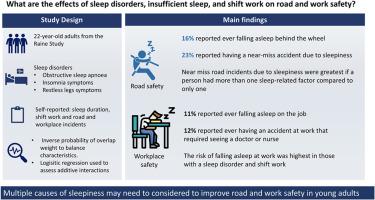Additive interactions of sleep disorders, insufficient sleep, and shift work on road and workplace safety incidents: A sufficient cause approach with overlap weights
IF 3.4
2区 医学
Q1 CLINICAL NEUROLOGY
引用次数: 0
Abstract
Background
Behavioural and biological factors impacting healthy sleep can influence road and workplace safety. This study investigated the additive interactions of sleep-disrupting factors (sleep disorders, insufficient sleep, and shift work) on road and workplace safety in young adults (22 years) from the Raine Study.
Methods
Employed participants (n = 439, median age 22.0 years, IQR 21.6–22.3) were assessed for common sleep disorders (obstructive sleep apnoea, insomnia, restless legs syndrome). They provided information on shift work status, habitual sleep duration (insufficient sleep <7 h), and self-reported road and work incidents. A sufficient cause approach with inverse probability of overlap weights and logistic regression was used to study additive interactions.
Results
Sleepiness while driving was reported by 16 % and while at work by 11 % of participants. Insufficient sleep alone increased the odds of falling asleep while driving (OR 2.29; 95 % CI 1.17, 4.32). Three sleep-disrupting factors additively increased the risk of near-miss road incidents (β, 1.40 > 0). Sleep disorders with shift work was associated with the highest risk of falling asleep at work (relative excess risk due to interaction, RERI; 4.86; 95 % CI, 2.9, 6.81).
Conclusion
The combined burden of multiple sleep-disrupting factors including sleep disorders, insufficient sleep and shift work, is associated with an increased risk of near-miss road incidents and falling asleep at work. Given that sleepiness, both on the road and in the workplace, is common in young adults, there is a need for greater awareness and intervention to address the associated risks.

睡眠障碍、睡眠不足和轮班工作对道路和工作场所安全事故的叠加相互作用:重叠权重的充分原因方法
影响健康睡眠的行为和生物因素会影响道路和工作场所的安全。本研究调查了来自Raine研究的22岁年轻人的睡眠干扰因素(睡眠障碍、睡眠不足和轮班工作)对道路和工作场所安全的相互作用。方法对439名参与者(n = 439,中位年龄22.0岁,IQR 21.6-22.3)进行常见睡眠障碍(阻塞性睡眠呼吸暂停、失眠、不宁腿综合征)评估。他们提供了轮班工作状态、习惯性睡眠时间(睡眠不足& 7小时)和自我报告的道路和工作事故的信息。利用重叠权值逆概率和逻辑回归的充分原因方法研究了加性相互作用。结果16%的人在开车时犯困,11%的人在工作时犯困。仅睡眠不足就会增加开车时睡着的几率(OR 2.29;95% ci 1.17, 4.32)。三种干扰睡眠的因素加在一起增加了道路意外事故的风险(β, 1.40 >;0)。轮班工作的睡眠障碍与工作时入睡的最高风险相关(由于相互作用的相对超额风险,rei;4.86;95% ci, 2.9, 6.81)。结论睡眠障碍、睡眠不足和轮班工作等多种睡眠干扰因素的综合负担与道路交通事故和工作时睡着的风险增加有关。考虑到困倦在年轻人中很常见,无论是在路上还是在工作场所,有必要提高意识并采取干预措施,以解决相关风险。
本文章由计算机程序翻译,如有差异,请以英文原文为准。
求助全文
约1分钟内获得全文
求助全文
来源期刊

Sleep medicine
医学-临床神经学
CiteScore
8.40
自引率
6.20%
发文量
1060
审稿时长
49 days
期刊介绍:
Sleep Medicine aims to be a journal no one involved in clinical sleep medicine can do without.
A journal primarily focussing on the human aspects of sleep, integrating the various disciplines that are involved in sleep medicine: neurology, clinical neurophysiology, internal medicine (particularly pulmonology and cardiology), psychology, psychiatry, sleep technology, pediatrics, neurosurgery, otorhinolaryngology, and dentistry.
The journal publishes the following types of articles: Reviews (also intended as a way to bridge the gap between basic sleep research and clinical relevance); Original Research Articles; Full-length articles; Brief communications; Controversies; Case reports; Letters to the Editor; Journal search and commentaries; Book reviews; Meeting announcements; Listing of relevant organisations plus web sites.
 求助内容:
求助内容: 应助结果提醒方式:
应助结果提醒方式:


